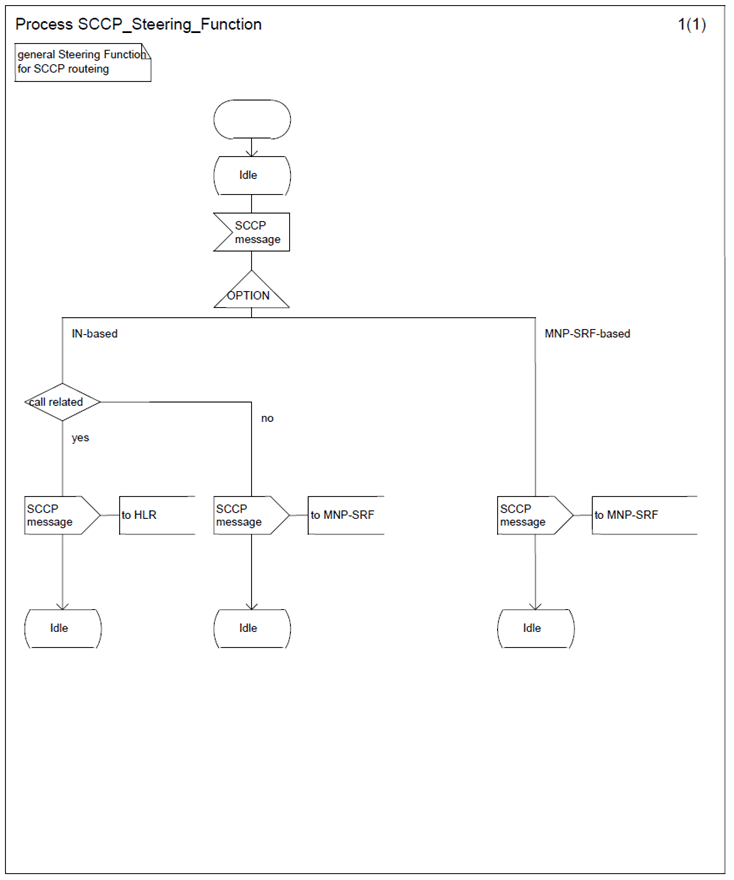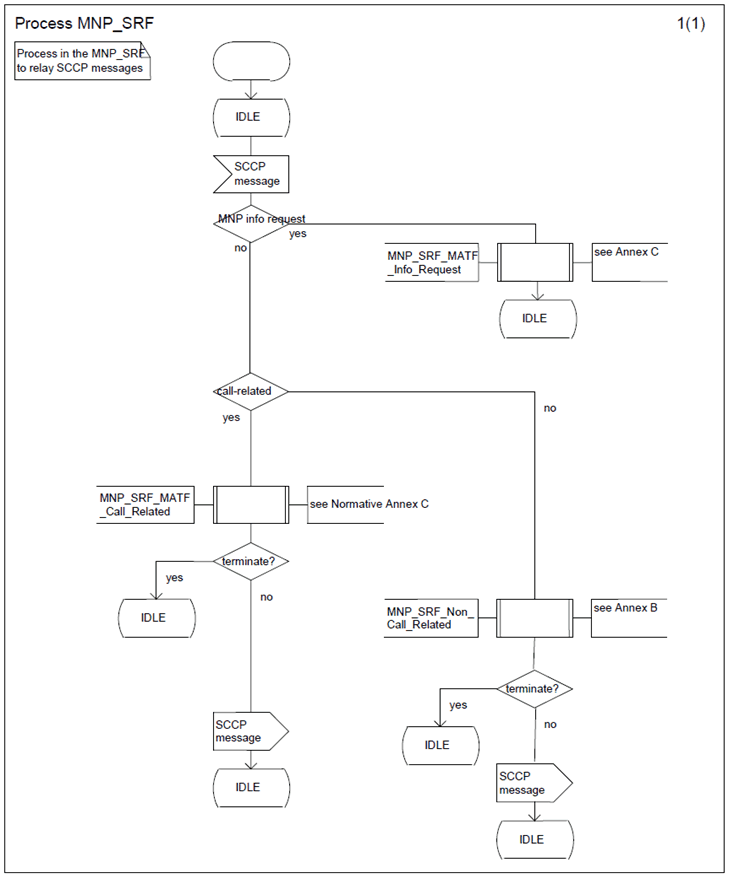Content for TS 23.066 Word version: 18.0.0
4 General p. 9
4.1 Overview p. 9
Mobile Number Portability (MNP) is the ability for a UMTS or GSM mobile subscriber to change the subscription network within a portability domain whilst retaining her original MSISDN or MSISDNs.
North American GSM Number Portability (NAGNP) is the ability for a subscriber to change subscription between North American GSM networks and other subscription networks within a regulated geographical area within North America.
As part of the porting process administrative actions have to be performed by the network operators of the number range holder network, donor network, recipient network and, as an option, by operators of other national UMTS or GSM networks as follows:
a)
b)
c)
Note that the order of sequence for the administrative actions to be performed both within a network and by different network operators is significant with respect to prevention of disruption in service to the mobile subscriber and prevention of looping calls between networks during the porting process.
Termination of a subscription for a ported number results in the deletion of any entry in an HLR and NPDB of that number.
If a call fails because databases are not correctly synchronised, the network entity that detects the inconsistency will raise an MNP specific alarm to the operation and maintenance subsystem.
The present document does not specify the porting process. It specifies the functionality needed to set-up calls to both ported and non ported subscribers including the functionality needed to query an NPDB for MNP information (in order to be able to charge correctly for CAMEL pre-paid calls and SMS) (Normative Annex A and Normative Annex C), and the functionality needed to relay non-call related signalling messages to the HLR in the subscription network (Normative Annex B) .
if the number range holder network is identical with the donor network:
| Recipient network: | add an entry in the HLR; add an entry in the Number Portability Database. |
| Donor network: | add an entry in the Number Portability Database; delete the entry related to the ported MSISDNs in the HLR. |
| Other networks in the portability domain: | add an entry in the Number Portability Database (if direct routeing is used). |
if the number range holder network is identical with the recipient network:
| Recipient network: | add an entry in the HLR; delete any entry related to the ported MSISDN in the Number Portability Database. |
| Donor network: | delete any entry related to the ported MSISDN in the Number Portability Database; delete the entry related to the ported MSISDNs in the HLR. |
| Other networks in the portability domain: | delete any entry related to the ported MSISDN in the Number Portability Database. |
if the number range holder network is different from both the recipient and the donor network:
| Recipient network: | add an entry in the HLR; add an entry in the Number Portability Database. |
| Number range holder network: | update the Number Portability Database |
| Donor network: | delete (or update) the entry in the Number Portability Database; delete the entry related to the ported MSISDNs in the HLR. |
| Other networks in the portability domain: | update the Number Portability Database (if an entry for the ported MSISDN exists). |
4.2 Compatibility p. 10
The IAM sent to the subscription network may contain additional routeing information. Within a portability domain the method how to convey the Routeing Number in the IAM between two portability networks shall be agreed upon by the two network operators involved (for an ITU-T ISUP solution see [6] and for an ANSI ISUP solution see [8] and [9]).
In general, IN-based and MNP-SRF (call-related) solutions are compatible and may coexist in the same portability domain. The only restriction refers to the case where the number range holder network relays call-related MAP messages (i.e. SRI for national calls) to the subscription network. If this solution is selected by at least one network operator within a portability domain, all the portability networks and transit networks affected must fulfil the following requirements:
- The SCCP interfaces between networks in a portability domain must be agreed. This refers to the SCCP addressing mechanism being used (e.g. number lengths, natures of address and translation types for call-related MAP messages). For messages that do not cross network boundaries the SCCP addressing mechanism is a choice of the network operator.
- The subscription network must be able to generate the SRI ack to allow the onward routeing of the call from the number range holder network to the subscription network.
4.3 Common Functionality of the MNP-SRF p. 11
In a PLMN that supports mobile number portability, SCCP messages sent to an HLR may be relayed by an MNP-SRF. Depending on the implemented solution (IN-based or MNP-SRF-based), on the type of message (call-related, non-call-related or MNP information request) and on the porting status of the called subscriber, the MNP-SRF may modify the SCCP called party address and route the message to a different HLR or to the subscription network, or terminate the dialogue and response to the INE.
Figure 1 shows the general steering functionality for SCCP message routeing. It shows the SCCP routeing principle for mobile number portability within a network.
Note that call related messages in the IN-based solution are not routed to the MNP-SRF. Therefore Normative Annex A of the present document does not mention the MNP-SRF.
However, the usage of the IN-based solution for the call-related messages should allow operators to have the routeing of the non call-related messages determined in the same database. See [7] for the description of the access of the MNP-SRF (node with relay capability) to the NPDB (external database).
In order to guard against the possibility that the porting data for an MSISDN is inconsistent between PLMNs in a porting domain, the SCCP hop counter may be used to prevent indefinite looping of messages between PLMNs. The MNP-SRF would then decrement the SCCP hop counter for every message that is relayed. It should be noted that the use of the SCCP hop counter requires the use of non segmented SCCP XUDT messages as defined in ITU-T 1996 SCCP recommendations or in the ANSI T1.112-1996 SCCP recommendations for North America, reference [11].

Figure 2 shows the process MNP_SRF in the MNP-SRF. The procedures MNP_SRF_MATF_Call_Related, MNP_SRF_Non_Call_Related and MNP_SRF_MATF_Info_Request are described in Normative Annex C and Normative Annex B of the present document. Note that in networks which support the IN-based solution for call related signalling, a distinction on SCCP level for call related and non-call related messages is needed and that the MNP-SRF does not require to include MATF's since call related messages and MNP information request messages are not terminated at the MNP-SRF.
The test "MNP info-request" is a test on the SCCP Translation Type if a dedicated Translation Type value for MNP information request messages is used in the network. The handling of SCCP messages in the MNP-SRF in networks which do not make use of a dedicated Translation Type value for MNP information request messages is for further study.
The test "call-related" is a test on the SCCP Translation Type if a dedicated Translation Type value for call related messages is used in the network. The handling of SCCP messages in the MNP-SRF in networks which do not make use of a dedicated Translation Type value for call related messages is for further study.
